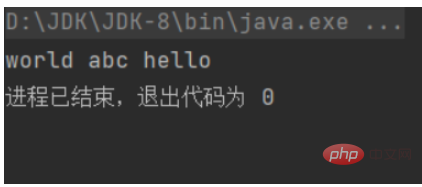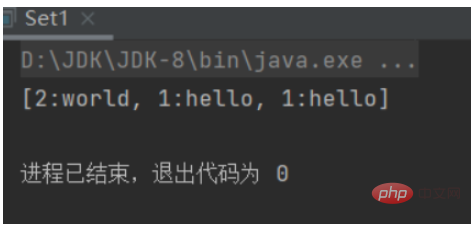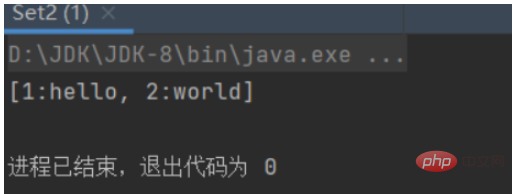How to use Set interface in Java to store arrays without duplicate elements
Set interface
The Set interface, like the List interface, inherits the Collection interface. The elements in the Set interface are unordered, and certain rules are used to ensure that the stored elements are not repeated.
HashSet collection
HashSet is an implementation class of the Set interface. The stored elements are non-repeatable, and the elements are unordered. When an object is added to the HashSet collection, First, the hashCode() method of the object is called to calculate the hash value of the object to determine the storage location of the element. If the hash values are the same at this time, call the equals() method of the object to ensure that there are no duplicate elements at this position.
package 集合类;
import java.util.HashSet;
import java.util.Iterator;
public class Set {
public static void main(String[] args) {
HashSet set=new HashSet();
set.add("hello");
set.add("world");
set.add("abc");
set.add("hello");
Iterator it=set.iterator();
while(it.hasNext()){
Object obj=it.next();
System.out.print(obj+ " ");
}
}
}Running results

package 集合类;
import java.util.HashSet;
class Student{
String id;
String name;
public Student(String id,String name){
this.id=id;
this.name=name;
}
public String toString(){
String s = id + ":" + name;
return s;
}
}
public class Set1 {
public static void main(String[] args) {
HashSet hs=new HashSet();
Student stu1=new Student("1","hello");
Student stu2=new Student("2","world");
Student stu3=new Student("1","hello");
hs.add(stu1);
hs.add(stu2);
hs.add(stu3);
System.out.println(hs);
}
} 
package API;
import java.util.HashSet;
class Student{
private String id;
private String name;
public Student(String id,String name){
this.id=id;
this.name=name;
}
//重写toString方法
public String toString(){
return id+ ":"+name;
}
//重写hashCode方法
public int hashCode(){
//返回id属性的哈希值
return id.hashCode();
}
public boolean equals(Object obj){
//判断是否是同一个对象
if(this==obj){
return true;
}
//判断对象是Student类型
if(!(obj instanceof Student)){
return false;
}
//将对象强转为Student类型
Student stu=(Student) obj;
//判断id是否相同
boolean b=this.id.equals(stu.id);
return b;
}
}
public class Set2 {
public static void main(String[] args) {
HashSet hs=new HashSet();
Student stu1=new Student("1","hello");
Student stu2=new Student("2","world");
Student stu3=new Student("1","hello");
hs.add(stu1);
hs.add(stu2);
hs.add(stu3);
System.out.println(hs);
}
}
The above is the detailed content of How to use Set interface in Java to store arrays without duplicate elements. For more information, please follow other related articles on the PHP Chinese website!

Hot AI Tools

Undresser.AI Undress
AI-powered app for creating realistic nude photos

AI Clothes Remover
Online AI tool for removing clothes from photos.

Undress AI Tool
Undress images for free

Clothoff.io
AI clothes remover

AI Hentai Generator
Generate AI Hentai for free.

Hot Article

Hot Tools

Notepad++7.3.1
Easy-to-use and free code editor

SublimeText3 Chinese version
Chinese version, very easy to use

Zend Studio 13.0.1
Powerful PHP integrated development environment

Dreamweaver CS6
Visual web development tools

SublimeText3 Mac version
God-level code editing software (SublimeText3)

Hot Topics
 1378
1378
 52
52
 Perfect Number in Java
Aug 30, 2024 pm 04:28 PM
Perfect Number in Java
Aug 30, 2024 pm 04:28 PM
Guide to Perfect Number in Java. Here we discuss the Definition, How to check Perfect number in Java?, examples with code implementation.
 Random Number Generator in Java
Aug 30, 2024 pm 04:27 PM
Random Number Generator in Java
Aug 30, 2024 pm 04:27 PM
Guide to Random Number Generator in Java. Here we discuss Functions in Java with examples and two different Generators with ther examples.
 Weka in Java
Aug 30, 2024 pm 04:28 PM
Weka in Java
Aug 30, 2024 pm 04:28 PM
Guide to Weka in Java. Here we discuss the Introduction, how to use weka java, the type of platform, and advantages with examples.
 Smith Number in Java
Aug 30, 2024 pm 04:28 PM
Smith Number in Java
Aug 30, 2024 pm 04:28 PM
Guide to Smith Number in Java. Here we discuss the Definition, How to check smith number in Java? example with code implementation.
 Java Spring Interview Questions
Aug 30, 2024 pm 04:29 PM
Java Spring Interview Questions
Aug 30, 2024 pm 04:29 PM
In this article, we have kept the most asked Java Spring Interview Questions with their detailed answers. So that you can crack the interview.
 Break or return from Java 8 stream forEach?
Feb 07, 2025 pm 12:09 PM
Break or return from Java 8 stream forEach?
Feb 07, 2025 pm 12:09 PM
Java 8 introduces the Stream API, providing a powerful and expressive way to process data collections. However, a common question when using Stream is: How to break or return from a forEach operation? Traditional loops allow for early interruption or return, but Stream's forEach method does not directly support this method. This article will explain the reasons and explore alternative methods for implementing premature termination in Stream processing systems. Further reading: Java Stream API improvements Understand Stream forEach The forEach method is a terminal operation that performs one operation on each element in the Stream. Its design intention is
 TimeStamp to Date in Java
Aug 30, 2024 pm 04:28 PM
TimeStamp to Date in Java
Aug 30, 2024 pm 04:28 PM
Guide to TimeStamp to Date in Java. Here we also discuss the introduction and how to convert timestamp to date in java along with examples.
 Java Program to Find the Volume of Capsule
Feb 07, 2025 am 11:37 AM
Java Program to Find the Volume of Capsule
Feb 07, 2025 am 11:37 AM
Capsules are three-dimensional geometric figures, composed of a cylinder and a hemisphere at both ends. The volume of the capsule can be calculated by adding the volume of the cylinder and the volume of the hemisphere at both ends. This tutorial will discuss how to calculate the volume of a given capsule in Java using different methods. Capsule volume formula The formula for capsule volume is as follows: Capsule volume = Cylindrical volume Volume Two hemisphere volume in, r: The radius of the hemisphere. h: The height of the cylinder (excluding the hemisphere). Example 1 enter Radius = 5 units Height = 10 units Output Volume = 1570.8 cubic units explain Calculate volume using formula: Volume = π × r2 × h (4




